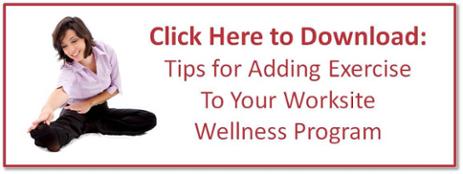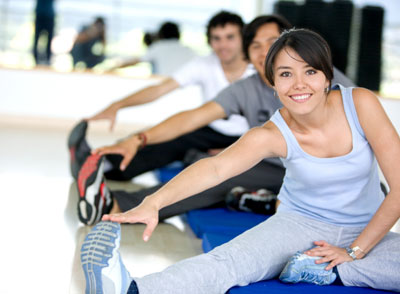.jpg?width=480&name=GettyImages-905323392%20(1).jpg) Let’s face it, daily life can be very busy and sometimes overwhelming to many of us. Trying to fit in exercise every day can seem like a chore and many times gets put at the bottom of the “to-do” list even though we all know it should be near the top. Just because you can’t fit in a trip to the gym or attend your favorite exercise class doesn’t mean that you can’t get exercise or at least some movement time throughout your day. Your body can even benefit from little bits of movement at a time if that is all you have time for, so there really should not be any excuses not to get some movement or exercise in your day.
Let’s face it, daily life can be very busy and sometimes overwhelming to many of us. Trying to fit in exercise every day can seem like a chore and many times gets put at the bottom of the “to-do” list even though we all know it should be near the top. Just because you can’t fit in a trip to the gym or attend your favorite exercise class doesn’t mean that you can’t get exercise or at least some movement time throughout your day. Your body can even benefit from little bits of movement at a time if that is all you have time for, so there really should not be any excuses not to get some movement or exercise in your day.
Exercise at Lunch
Lunch breaks are a great time to fit in exercise. Bring your tennis shoes to work and take a walk. It can be around the building inside or outside, through a neighborhood nearby, or on a treadmill if that is available to you. Walk for as much time as your schedule allows. If you don’t have time for a shower afterward, just don’t push yourself quite as hard. Walking is great for your body!
Getting in Extra Steps During the Workday
You can fit in exercise in your office! Take the stairs between floors—skip that elevator! Park far away on purpose so you get a 5- or 10-minute walk in and out of your office. That could potentially add up to 20 minutes of movement or exercise depending on how fast you walk. Here are a few other tips for getting more exercise at work.
Move While You’re Waiting on the Kids
If you are a parent, chances are your kids are or will be involved in activities. So many times parents just drop their child off and sit in their cars to wait, or just leave to do something else. Your child is getting their exercise, why not get yours as well? You can take a walk, run, or ride your bike around the area they are practicing in so as to maximize your time. For those days when there are games, the kids usually need to be there early to warm up, so you can use that warmup time to move your body as well instead of sitting in your chair or car for that extra 30 to 60 minutes.
Work Out at the Park
If you frequently take your kids to parks, work out at the park while they play! Park benches are great for pushups, dips, lunges, squats, and step-ups. Monkey bars work well for pull-ups, and running up the steps and sliding down the slides is a little cardiovascular work—not to mention fun! Don’t forget, you can use your kids as little (or big) weights and resistance machines, too!
Plan Active Gatherings
Plan family and friend time as active gatherings. Take walks, go on bike rides, or go swimming (or sledding, ice skating, or skiing in winter) together. You can still talk while doing many of those activities. Join a gym with a friend so your social time also becomes your exercise time.
There is no rule that says all exercise has to be at a gym or that you have to set aside 30 to 60 minutes every single day to purposely do one set workout. You should find an activity that you enjoy doing and incorporate that into your daily life. Everyone has different goals and will have different needs for exercise, but with a few modifications in your daily routine you should be able to start moving more and sitting less throughout the day.


.jpg?width=392&height=221&name=Exercise%20Sticky%20Note%20GettyImages-809071406%20(1).jpg) There is more and more discussion in corporate wellness today about doing wellness for (with?) employees,
There is more and more discussion in corporate wellness today about doing wellness for (with?) employees, 
 We have all made the excuse that we don’t have the time to exercise. If you have children, this excuse is even more likely. You have to get the kids ready in the morning, you work all day, you get off work, pick up the kids, and take them to their after-school activities. After that you’re finally getting home to cook dinner and relax with the family. Upon finishing dinner, it’s time to shower and go to bed. Now, I know that may feel like an exhausting day and that you have no time for yourself, but if you really look for it there is plenty of time to fit in some exercise.
We have all made the excuse that we don’t have the time to exercise. If you have children, this excuse is even more likely. You have to get the kids ready in the morning, you work all day, you get off work, pick up the kids, and take them to their after-school activities. After that you’re finally getting home to cook dinner and relax with the family. Upon finishing dinner, it’s time to shower and go to bed. Now, I know that may feel like an exhausting day and that you have no time for yourself, but if you really look for it there is plenty of time to fit in some exercise. 
 There’s a lot of misinformation out there on what is and is not good for you. The science changes all the time; unfortunately, changes in health information can
There’s a lot of misinformation out there on what is and is not good for you. The science changes all the time; unfortunately, changes in health information can 





 Need a convenient, cost-effective way to get in shape and get healthy?
Need a convenient, cost-effective way to get in shape and get healthy?
 Stairs are a great way to take your same old cardio workout to the next level. Changing it up by utilizing the stairs might have your muscles twitching like never before! Take a look at your workout routine, you possibly neglect your lower body more than you think. Many people consider their cardio activities their lower body workout because they are walking, running, biking, etc. Exchange your regular cardiovascular exercise for a stair workout and not only will your heart be pumping, your muscles will be telling you that stair workout gave them a run for their money!
Stairs are a great way to take your same old cardio workout to the next level. Changing it up by utilizing the stairs might have your muscles twitching like never before! Take a look at your workout routine, you possibly neglect your lower body more than you think. Many people consider their cardio activities their lower body workout because they are walking, running, biking, etc. Exchange your regular cardiovascular exercise for a stair workout and not only will your heart be pumping, your muscles will be telling you that stair workout gave them a run for their money!